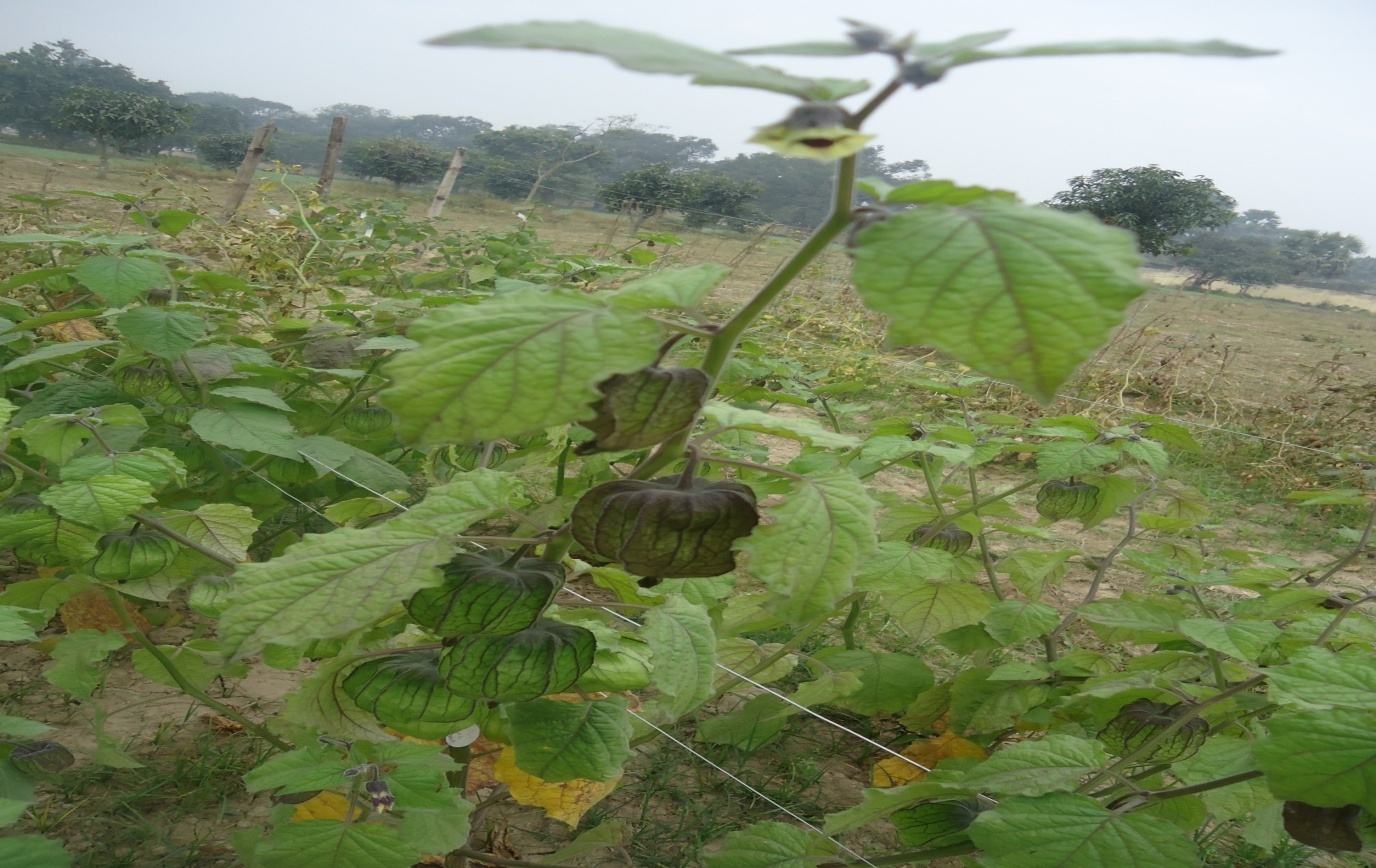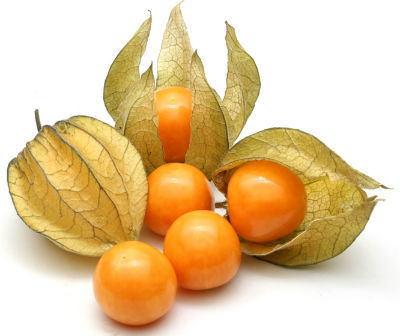रसभरी या केप करौदा: भारत में एक नई नकदी फसल
 Introduction and adaptations of new crops contribute to an increase in diversity of agricultural systems. It offers new opportunity and alternatives to farmers and markets. New crops can result in an increase of income for farmers.
Introduction and adaptations of new crops contribute to an increase in diversity of agricultural systems. It offers new opportunity and alternatives to farmers and markets. New crops can result in an increase of income for farmers.
The Cape gooseberry (Physalis peruviana L.) करौदा is a new herbaceous crop which comes under minor fruit.
The genus Physalis, of the family Solanaceae, contains around more than 100 species of annual and perennial herbs.
Several species of Physalis are grown for their edible fruits like, P. peruviana L. (Cape gooseberry) , P. pruinosa L. (strawberry tomato), or P. ixocarpa Brot. (husk tomato).
This crop can be grown successfully in kitchen garden. In India, Cape gooseberry grown ‘throughout the plains and hills. In temperate region it grow as a annul while in tropical and subtropical grow as perennial due to absence of frost.
It is also called golden berry, teparee, tiparee, makowi, poha, uchuba etc.
Gooseberry reaches 2 to 3 ft (1.6 - 0.9 m) in height but occasionally may attain 6 ft (1.8) m. Cape gooseberry can also be grown as an intercrop with other fruit crops.
The Cape gooseberry fruits are cherry size, golden-yellow, like a small globe and is deliciously sweet. The fruit type is berry with the diameter about 12.5 to 25.0 mm and the weight ranges from 4 - 10 g, which contain about 100-300 seeds per fruit.
It is a good source of carotene and ascorbic acid. It is a useful small crop for the home garden.
It can even be sundried. The fruits of Cape gooseberry have an increasing presence in exotic fruit markets they may be interesting for the diversification of horticultural production. It gives quick returns to the growers.
Landscape Value of Gooseberry
It Grows well in a pot and give good look. It may be used as border plant and border filler. Some species like P. alkekengi (winter cherry or Chinese lantern) especially grown for ornamental purpose.
Nutritive value of Gooseberry
It is a good source of vitamins A, C & B and iron. It is high in protein and phosphorus compare to other fruits. But it is low in calcium. The fruits are rich in alkaloids, flavonoids, carotenoids and bioactive compounds considered functional ones.
Table: Nutritional value per 100 g edible portion
| S.No. | Nutrients | Quantity( per 100 g) | Nutrients | Quantity(per 100 g) | |
| 1. | Energy | 222kJ (53kcal) | 7. | Riboflavin (vit. B2) | 0.04 mg (3%) |
| 2. | Carbohydrates | 11.2 g | 8. | Niacin (vit. B3) | 2.8 mg (19%) |
| 3. | Fat | 0.7 g | 9. | Vitamin C | 11 mg (13%) |
| 4. | Protein | 1.9 g | 10. | Calcium | 9 mg (1%) |
| 5. | Vitamin A | 36 μg (5%) | 11. | Iron | 1 mg (8%) |
| 6. | Thiamine(vit.) | 0.11 mg (10%) | 12. | Phosphorus | 40 mg (6%) |
Source: wikipedia.org/wiki/Physalis peruviana
 Uses of Gooseberry fruits
Uses of Gooseberry fruits
The fruits can be eaten fresh and dried. The fruits are excellent in crumbles or raw with ice cream. It is ideal for snacks, pies and jam making because it rich in pectin with mildly tart flavour.
It also used puddings, chutneys and ice cream. It is relished in salads and fruit salads. In Colombia, the fruits are stewed with honey and eaten as dessert.
The British use the husk as a handle for dipping the fruit in icing. In Europe it is dipped in chocolate or used to decorate pastries.
Medicinal uses of Gooseberry:
The leaf decoction is used as diuretic and antiasthmatic. It was found to inhibit both Gram-positive and Gram-negative bacteria (Jaca and Kambizi, 2011).
Wu ShuJing et al. (2009) describe that it is popular as a folk medicine in Taiwan and used for treating cancer, leukemia, hepatitis and rheumatism diseases.
It also has anti-bacterial and anti-inflammatory properties. It is used medicinally as a diuretic and anthelmintic, and in abdominal disorders.
Ascher et al., 1981; Calderon et al., 2012 reported that Physalis peruviana is a source of 4 beta–hydroxywithanolide which is an insect antifeedant against Spodoptera littoralis.
It has provided preliminary evidence that its constituents, possibly polyphenols and/or carotenoids, may have anti-inflammatory and antioxidant properties.
Cape gooseberry juice regulates cholesterol levels and protects the liver from oxidative stress.
Climate to grow Gooseberry:
The plant needs full sun. The average relative humidity from 70 to 80% is ideal during the growing season. It is very susceptible to strong winds, so, its cultivation should be protected by windbreaks.
The seeds have a high germination percentage, about 85 to 90% and they germinate 10 to 15 days after sowing. It germinates more easily at 7 to 13°C at night temperature and 22 to 28°C day temperature.
It requires frost free conditions because frosts can burn the plants. Prune back after all frosts have passed. It can set fruit successfully without problems if the minimum temperature is above 50C.
Soil to grow Gooseberry
The ideal soil for cropping is well drained sandy-clayey and should be rich in organic matter (greater than 4%) with 5.5 6.8pH. It is a relatively hardy plant and can be grown in poor and degraded soils.
It can tolerate moderate salty marine conditions. It best thrives on well drained sandy to gravelly loams soil.
Under highly fertile alluvial soil, there is much vegetative growth but fruits fail to colour properly.
Propagation of cape gooseberry
It is commercially propagated by seed but may be propagated by stem cuttings treated with rooting hormone. The cutting plants are grown flower early and yield well but are less vigorous than seedlings. (Morton, 1987) reported the propagation by ‘air-layering’. But air-layering is not often practiced.
Sowing of cape gooseberry
Seeds are sown in seedbeds. In India, sowing time vary with the agro climatic conditions and growing regions. Generally seed can be sown April to August.
Field Preparation
The field is prepared to a fine tilth by giving 2 to 3 ploughings and mixed 20 tons FYM per hectare. The field should be divided in to small plots for convenience of transplanting and irrigation.
Planting
The seedling should be transplant when they attain 15-20 cm height. Planting in early spring good for an early fruiting. Where drainage is a problem, the plantings should be on gentle slopes or the rows should be mounded. The plants are planted at 0.50 to 1.50 meters. The field should be irrigate immediately after planting.
Irrigation
It is very susceptible to drought and requires regular watering during the growing. The plants become dormant in drought. In dry seasons, irrigation is necessary to keep the plant in production.
Nutrient Management
Prasad et al (1985) observed that the application of 100 kg nitrogen, 60 kg P2O5 and 60 kg K2O /ha produced highest yield with highly juicy fruits. Foliar spraying of 1% potassium chloride before and just after blooming enhances fruit quality.
Potassium promotes the flowering and fruits fixation. Calcium plays an important role in tissues and calyx formation. Boron is the most required micronutrient because its deficiency reduces the TSS content of the fruit.
Cultural Practices
Using some cultural practices like fertilization, training, pruning and sprouting, it is possible to improve the plant canopy as well to contribute on quality and appearance of the fruit.
Pruning
Pinch out new shoots to encourage bushy growth. Prune back hard in spring promotes the new growth for fruiting.
Flowering and fruiting
Flowering and fruiting vary with cultivar, locality and agro climatic condition. Fruit buds are produced after 12 to 13 stem internodes are formed. The flowers are hermaphrodite which have both male and female organs.
It is a self-pollinated crop but pollination can be enhanced by a gentle shaking of the flowering stems or giving the plants a light spraying with water. After the flower falls, the calyx expands, forming a straw-colored husk much larger than the fruit enclosed, which take 70 to 80 days to mature.
Harvesting of the fruit usually happens about 60 to 100 days after flowering when the husk has turned straw color.
The fruiting season lasts from February through May. Although no fruits remained on the plants to maturity until the cooler months of winter when a good yield was obtained.
Pest and Diseases
In South Africa, the most important of the many insect pests that attack the Cape gooseberry are cutworms, in seedbeds. In India, mites may cause defoliation and it can be controlled with the spray of wetable sulphur @ 1.5 gm/liter water. Hares damage young plants and birds (francolins) devour the fruits if not repelled.
The most diseases are powdery mildew and leaf spot and it can be controlled with the spray of wetable sulphur @ 1.5 gm/liter water and 0.4% Filton at 15 days interval..
The plants are prone to root rots and viruses if on poorly-drained soil or if carried over to a second year. Therefore, farmers favour biennial plantings. In India, a strain of tobacco mosaic also affect crop.
Picking:
The fruit become ready to harvest about 55 days after harvest anthesis and it should be picked at fully ripe stage when the husk stars dry and berry become ripe and sweet.
When the colour of fruit change to yellow-orange indicate the ripening. The fruit may also be picked partially green and allow to ripe, but harvesting at decoding stage has great important to get sweet as on plant ripened fruits. The fruit are picked every 2-3 weeks.
Yield of Gooseberry
The Yield depends upon agro climatic condition, locality and orchard management practices. Nutrient management being one of the prime considerations for higher yield. A single plant may yield up to 300 fruits under ideal conditions.
Average yield varies with 4.5-6 tons per hectare. But it has potential production up to 10 tonnes per ha under proper management. Naik (1949) reported that the perennial variety was high yielder.
Storage
If the fruit is left inside the intact calyx husks and it about 30–45 days shelf life at room temperature. In case of storage fruits should be stored at 2-4ºC. In cool storage at 2 0C temperature, the fruits will keep for four to five months.
Marketing
The fruit may be sent to local market directly after harvesting and Properly packed fruits can be can be set to distant market. Icontec (2004) recommended plastic packing boxes with 7-7.5 kg fruits and maximum height of 250 mm.The fruits are usually dehusked before delivery to markets.
References
Chattopadhyay, T.K. (2008). A text book of Pomology Vol-II, Kalyani Publishers Calcutta, India.285-290.
D.B. Singh, S. Lal, N. Ahmed, S.N. Qureshi and A.A. Pal (2011). Screening of cape goose berry (Physalis peruviana) collections for adaptation under temperate ecosystem. Progressive Horticulture.43 (2):211-214.
Prasad, I.D., Sengupta, B.N.Singh, R.K. and Singh, S.P.(1985).Haryana Journal of horticultural Science,44(3-4):151-55.
Singh, D.B. Pal, A.A., Lal, Shiv, Ahmed, N. And Mirza, Anis (2012).Growth and developmental changes of Cape gooseberry fruits. Asian J. of Hort., 7(2):374-378.
Kour and Bakshi (2006).Comparative performance of some cape gooseberry strains under Amritsar conditions. Haryana J.Hortic.Sci., 35(3&4).263-264.
MunizI, KretzschmarI Rufato, PelizzaI, A.D. Rufato Macedo (2014). General aspects of physalis cultivation Ciência Rural, Santa Maria, v.44, n.6, p.964-970.
Morton, J. (1987). Cape gooseberry. p. 430–434.
Authors
*Sachin Tyagi and Sanjay Sahay
Department of Horticulture (Fruit & Fruit Technology), Sabour, Bhagalpur-813210 (Bihar), India
* E-mail:
